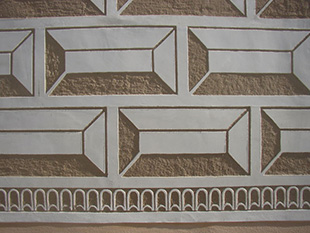












A combed wall surface is produced by dragging a comblike tool over a prepared surface, producing stripes or waves.
Sgraffito has been used in Germany since the 13th century, was common in Italy in the 16th century, and can currently be found in African art. Kut-kut, a lost art of the Philippines implements sgraffito and encaustic techniques. Practiced by indigenous tribe of Samar island around 1600 to 1800 A.D.
In Germany the technique is most predominant in Bavaria, shown in its native motifs. The use of Sgraffito was common in the creation of housing façades for the purposes of advertising.
In combination with ornamental decoration these techniques formed an alternative to the prevailing painting of walls. Of late there has been an unmistakable growing interest in this old technique, which as a means of expression can be introduced into various artforms. The technical procedure is understandably simple, and the procedures are the same as with the painting of frescoes.
By Appointment
PARIS CERAMICS
South Park Studios - Suite 10
88 Peterborough Road, London SW6 3HH
United Kingdom